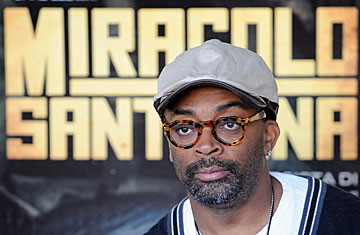
When it comes to history, Spike Lee isn't one to duck a fight. Last spring the New York filmmaker set off a nasty public showdown with Clint Eastwood, whom he criticized for not depicting African-American soldiers in his recent World War II films about Iwo Jima.
But now Lee finds himself defending the historical accuracy of his own World War II movie, Miracle at St. Anna, and this time he is up against real-life fighters who may be even tougher than Dirty Harry. Surviving members of Italy's underground anti-Nazi resistance movement are angry over the film, a fictionalized account of the travails of the 92nd Infantry Division — the black GIs known as Buffalo Soldiers — as they helped liberate Italy. The film includes a portrayal of the Nazis' infamous 1944 slaughter of some 560 Italian civilians in the Tuscan town of Sant'Anna di Stazzema.
In Lee's version, that massacre is depicted as a response to the actions of the Italian resistance fighters and shows one partisan betraying the town in a secret meeting with the Nazis.
But in a 2005 ruling, an Italian military tribunal determined that the massacre was a premeditated plan by the Germans and was in no way provoked by the partisans. Moreno Costa, 82, who fought alongside the African-American unit, was among the former resistance fighters who waged that legal battle, and he met Lee last year before filming began. "He talked about commemorating the Buffalo troops, but he didn't say anything about this betrayal," said Costa, reached by phone in his hometown of Pietrasanta, some six miles from St. Anna. "We are indignant about this. I don't understand why he had to open all this up again."
Giovanni Cipollini, who heads Pietrasanta's local pro-resistance association, said he had offered to put Lee in touch with partisans who were present, but that the director refused. "This is very delicate," he says. "When a famous director makes a major movie about a chapter in history, people will believe that his version is the truth." Cipollini led a group distributing flyers of protest at Wednesday's screening in Viareggio, near the setting of the film.
Lee has said he wanted to make this film, based on a novel by James McBride, to give long-overdue attention to the role of African-American soldiers in World War II. While at work on it, Lee took a swipe at Eastwood over the absence of black soldiers in his historical epics Flags of Our Fathers and Letters from Iwo Jima. The Californian director fired back: "A guy like that should shut his face," to which Lee replied, "The man is not my father, and we're not on a plantation either."
Characteristically, Lee has not backed down on the European front either. In a press conference after Monday's screening of his film in Rome, his response to the hurt feelings of the Italian resistance was firm. "I am not apologizing for anything," he said. "I think these questions are evidence that there is still a lot about your history during the war that [Italians] have got to come to grips with." He was also quoted in the Italian press as saying there were plenty of cases of resistance fighters fleeing from combat.
Costa, who was 18 years old when he fought in 1944 in the battles around St. Anna, says he will not see the film, especially in light of Lee's reply to the historical questions. "Spike Lee can make whatever film he wants," he says. "I don't know why he wanted to insert that [betrayal] scene. Now he doesn't want to apologize, and attacks us? He could have just kept quiet."
For his part, McBride, who also wrote the screenplay, took a more conciliatory approach at Monday's press conference. "I am very sorry if I have offended the partisans. I have enormous respect for them," he said. "As a black American, we understand what it's like for someone to tell your history, and they are not you. But unfortunately, the history of World War II here in Italy is ours as well, and this was the best I could do." In the words of the screenwriter and the director, one can see the difference between a peacemaker and a warrior.
